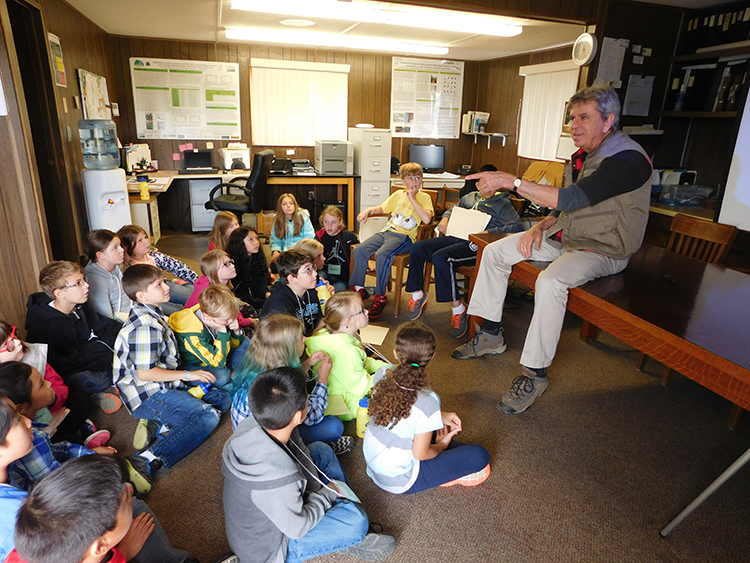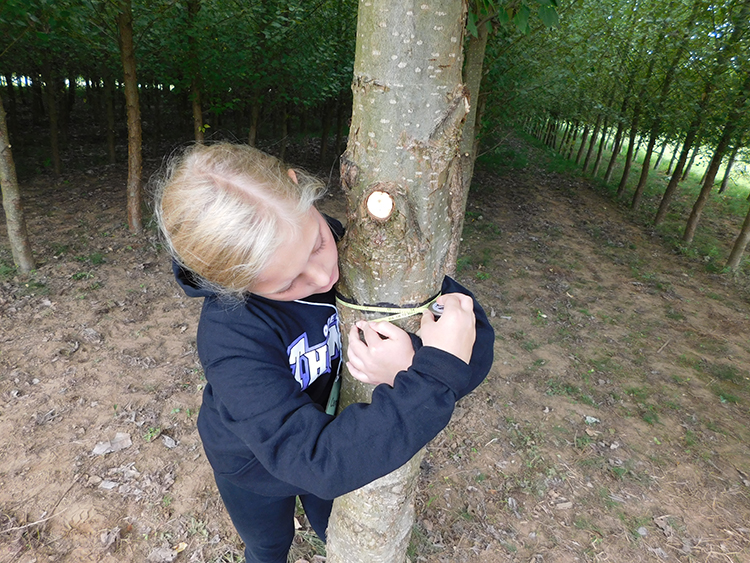By Adriene Koett-Cronn, Oregon State University | June 2016
Nearly 100 third grade scientists gathered to present their findings to researchers at GreenWood Resources in Westport, Oregon after studying hybrid poplar phenotypes. The field trip was the finale of a genetics unit that began nine weeks earlier at Jackson Elementary School in Hillsboro, Oregon.
It Began with a Discovery Day

The budding scientists began their exploration of basic genetic and bioenergy concepts during a hands-on discovery day held at their school in March. During that event, students were treated to a high-energy, crash course in genetics by Brian Stanton, the Chief Science Officer at GreenWood Resources and lead of the AHB feedstock team. Stanton introduced the concepts of phenotypes and genotypes; how scientists use these concepts in plant breeding; and how researchers at GreenWood Resources use genetics to develop fast-growing hybrid poplar trees that are used to make biofuels and other chemicals.
The students also did a set of hands-on experiments with members of the Oregon State University Bioenergy Education Initiative, which is part of AHB’s education efforts. Students made mini bioreactors in plastic bags and learned how the fermentation chemistry is similar to what happens in commercial, full-sized bioreactors. They also extracted DNA from strawberries and discussed how scientists use genetics to breed hybrid poplar trees. Finally, they learned how plants store the sun’s energy as sugar, and how that sugar energy is converted into renewable fuels and chemicals.
“The ‘oohs and awes’ heard when the bioreactors were expanding before their eyes, and when the strawberry DNA coalesced in the cup, were true measures of their excitement. Every student was hooked on the magic of science,” reflected Mary Hall, the lead teacher at Jackson Elementary.
The Research Challenge
Stanton and his team wrapped up the day by outlining the research project the students would be conducting over the coming weeks. The research involved caring for a mix of 24 hybrid poplars seedlings that GreenWood Resources had brought to the school. The trees included four trees from each of the six different genotypes. Students needed to observe a series of phenotype characteristics (leaf shape, color, tree height, petiole length, etc.) of the trees and keep careful notes. Using these observations, students were challenged to group the trees based on similar phenotypes and match them to their genotypes.
Teams of students were assigned to a plant which they had to care for during the unit. They watered the trees daily with precise amounts of water, gently raked the top of the soil to prevent caking and made sure the plants received adequate light. Hall said students took their responsibility for the trees’ care seriously. Some students even took to talking to their plants and gently petting the plants. “It was like we had classroom pets. The students were so attached to these trees.” Under the young scientists’ care, the trees thrived. Over nine weeks, students recorded their observations about the trees’ phenotypes, keeping detailed notes, taking measurements, and charting the trees’ growth and other changes.
The cross curricular unit touched many different subject areas including biology, botany, language arts, and math. The unit also included elements of geography when students identified the native regions of the different parent plants and the conditions in which they thrive. Economics was also part of this unit as students learned how locally grown trees were harvested to produce local fuels, providing jobs, and renewable fuels and chemicals.
Field Trip Show and Tell

In early June, the students’ shared their weeks of work with researchers at GreenWood Resources during their field trip. They gave presentations on their observations and conclusions on how the trees were grouped based on phenotypes and how they used that information to match trees to their genotypes. Said Hall, “We have future botanists, geneticists, and scientists as a result of this project! I have a few students especially captivated by the idea that biofuels help reduce our carbon footprint, because trees take in carbon dioxide and biofuels burn more cleanly–the future is bright with these keen minds.”
Staff and researchers at GreenWood Resources then set up stations to show students how they create hybrid crosses of trees and grow them from seed. Students pulled the “cotton” from the poplar catkins, and saw how the seeds were removed using a high pressure air hose. They then learned how the seeds were planted, grown, and used as cutting material to produce thousands of hybrid trees.
The students also learned how the trees are cared for on the farm and carefully monitored and measured. The mini botany lesson included looking at growth rings, using light meters to read how much light a stand of trees receives, and measuring trees’ growth.

Said Stanton of the student scientists, “GreenWood is thrilled to see so much enthusiasm among the students for what we are doing in developing a renewable and sustainable source of biomass energy feedstock for Oregon’s future biofuels industry.”
Hall echoed this thought as she excitedly reported on her students taking notes, labeling diagrams, asking thoughtful questions and thinking creatively throughout the nine-week unit. What did the students think of the project? Grace G. said, “It inspires me when I get older to learn more about making biofuels and genetics to help the work with biofuels.” Finneus said, “I can’t wait to see a world of bioeverything!” Bronwynn was clearly captivated by the farm and said, “I’m going to make a tree farm and go to Oregon State University.” And, finally Bri offered this sentiment, “GreenWood Resources makes the world a better place.”
The OSU Bioenergy Education Initiative will be publishing the lesson, titled Growing Bioenergy, on its website. GreenWood Resources has generously offered to provide cuttings to regional classrooms wanting to replicate the lesson. For more details visit http://agsci.oregonstate.edu/bioenergy-k-12/bioenergy-lessons.
